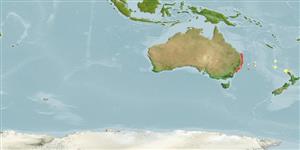>
Batrachoidiformes (Toadfishes) >
Batrachoididae (Toadfishes) > Halophryninae
Etymology: Batrachomoeus: Greek, batrachos = frog + Greek, momai, mao = to get excited, to be roused (Ref. 45335).
Environment: milieu / climate zone / depth range / distribution range
Ekologi
laut; payau dasar (demersal). Subtropical; 25°S - 35°S
Southwest Pacific: Endemic to Australia.
Size / Weight / umur
Maturity: Lm ? range ? - ? cm
Max length : 35.0 cm TL jantan/; (Ref. 33839)
Inhabits the continental shelf. Also found in inshore waters (Ref. 7300).
Life cycle and mating behavior
Kematangan | Reproduksi, perkembang biakan | Pemijahan | telur-telur | Fecundity | Larva
Paxton, J.R., D.F. Hoese, G.R. Allen and J.E. Hanley, 1989. Pisces. Petromyzontidae to Carangidae. Zoological Catalogue of Australia, Vol. 7. Australian Government Publishing Service, Canberra, 665 p. (Ref. 7300)
Status IUCN Red List (Ref. 130435: Version 2024-1)
ancaman kepada manusia
Harmless
penggunaan manusia
Alat, peralatan
laporan khas
muat turun XML
Sumber internet
Estimates based on models
Preferred temperature (Ref.
123201): 16 - 24.3, mean 20.4 °C (based on 14 cells).
Phylogenetic diversity index (Ref.
82804): PD
50 = 0.5312 [Uniqueness, from 0.5 = low to 2.0 = high].
Bayesian length-weight: a=0.00389 (0.00180 - 0.00842), b=3.12 (2.94 - 3.30), in cm total length, based on all LWR estimates for this body shape (Ref.
93245).
Trophic level (Ref.
69278): 3.6 ±0.5 se; based on size and trophs of closest relatives
Daya lenting (Ref.
120179): sedang, Waktu penggandaan populasi minimum 1.4 - 4.4 tahun (Preliminary K or Fecundity.).
Fishing Vulnerability (Ref.
59153): Low vulnerability (25 of 100).
